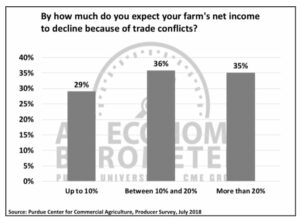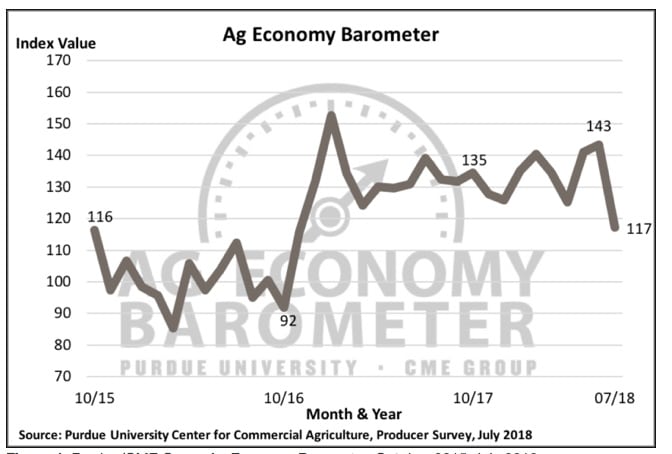Results are in from the July Ag Economy Barometer and producers have low expectations for the year ahead. However, those in the seed industry remain optimistic.
Driven by commodity prices and the impacts of trade tariffs, farmers are increasingly pessimistic about the overall ag economy, according to the results of Purdue University’s Ag Economy Barometer July report.
Each month, agricultural economists poll 400 farmers located around the nation to get their opinions and perspective on the agricultural economy. This month’s results are a sharp departure from the previous months, says Jim Mintert, the barometer’s principal investigator and director of Purdue’s Center for Commercial Agriculture.
The index fell to 117 from 143 from one month ago, Mintert says, noting that it’s the largest one-month barometer decline since 2015 when researchers started the Purdue Ag Economy Barometer.
“The decline in the barometer was driven by both a decline in people’s perception of current conditions in the ag economy, as evidenced in the barometer falling from 138 to 99 in July, but also a decline in future expectations,” he says. “The future expectations index fell from 146 to 126.”
When comparing results of the July report to the June report, the percentage of farmers who said their operation was worse off compared to a year ago skyrocketed, hitting 55 percent in July versus June’s 38 percent.
Furthermore, the percent of people who thought bad financial times in the ag economy were ahead jumped from 46 percent to 61 percent in July. At the same time, Mintert says they saw a decline in the percent of people expecting good times. That number moved from 26 percent in June to 19 percent in July.
As one might expect from the numbers above, farmers do not think it’s a good time to be investing in the farm.
As a result, 31 percent of respondents expect lower farmland prices. Mintert says a month ago, that number was only 21 percent.
“As you look at the data, that takes us back to where we were in the spring and summer of 2017,” he says. “We had been looking at an ongoing improvement in people’s perspectives of where farmland prices were headed. We’ve now given up those gains.”
A driver of producer sentiment is the impact of President Trump’s trade strategy.
“One of the big concerns among producers has been the trade conflict, especially with China and the NAFTA countries,” Mintert says.

“People are more concerned about the prospects of an ongoing trade war than they were earlier in the year,” Mintert says.
The subsequent question asked producers if they expected to see a decline in their farm’s net income due to trade conflicts, of which 70 percent responded “yes.” Of those who responded “yes,” 29 percent thought their net farm income would go down up to 10 percent in 2018. Meanwhile, 36 percent thought their net farm income would decrease between 10 and 20 percent, and 35 percent thought their net farm income would decrease by more than 20 percent.
On the corn side, Mintert says producers are pretty negative. The number of respondents who expect December corn futures to trade below $3.25 per bushel between mid July and fall 2018 is 38 percent. For soybeans, 41 percent of respondents expect November soybeans to trade below $8 per bushel before they go off the board later this fall.
Seed Insights
While farmers are pessimistic on the ag economy, some in the seed industry remain optimistic about the sales season ahead.
“We should have adequate supply of seed to meet 2019 seed needs,” says Dave Nanda, director of genetics and technology at the Ohio-based Seed Consultants, LLC. “Most seed companies try to produce more than enough seed to meet their demands. However, with seed company mergers, supply and demand is going to fluctuate. I think there may be seed shortages of non-GMO seeds, as well as Liberty-tolerant seeds.
“I see more growers shifting to Liberty-tolerant products to control glyphosate resistant weeds. Seed companies with more disease resistant hybrids and shorter hybrids that can tolerate higher population density may gain market share.”
Up in Michigan, Christine Varner, president of D.F. Seeds, LLC, shares that most growers in the area will stick to having soybeans in their rotation.
“The most progressive growers forward contracted beans in the $10.50 per bushel area, so they are sitting well,” Varner says. “Overall, I think our soybean sales will be up, driven by GT27, Liberty Link and non-GMO seed sales.
In terms of production, Varner and Joe Merschman, president and CEO of Merschman Seeds, Inc., in Iowa, also expect to have adequate supplies of seed.
“I expect that I will sell out of GT27 and Liberty Link seed,” Varner explains. “I expect to have inventory of R2Y at the end of the season. There is a lot of interest in planting the GT27 soybeans, since they received Philippine approval a few weeks ago.
“I expect to sell all I’m having produced. We need some consistent August rains to make yield on those.”
Merschman agrees, saying there could be shortages of the new trait LibertyLink GT27, particularly in the Group IV maturities.
“If the dicamba post application label is not renewed in November of this year, there could be tightness in LibertyLink soybeans, where weed resistance is a major problem.”
SUBHEAD: Eyeing Premiums
Given the commodity prices and expectations on the year ahead, farmers will be eyeing ways to increase income.
“I expect that farmers will be very conscious about input costs and will be challenging their suppliers to a better price, or more value,” Merschman says.
Because of this, Varner expects many growers to be looking at non-GMO soybeans in her area because of the premiums offered.
“With the soybean prices where they’re at, if growers can make another $1.25 to $1.50 per bushel in premiums, they will do it,” she says, adding that DF does not sell many Xtend soybeans. “I expect that the national companies will get into a price war on Xtend soybeans this year as there is a lot of production out there that they’ll need to sell. If the Environmental Protection Agency doesn’t renew the approval, a huge supply issue could arise in the soybean seed arena.”
For the complete Purdue Ag Economy Barometer report, visit ag.purdue.edu/commercialag/ageconomybarometer













